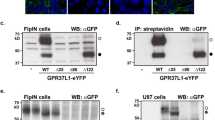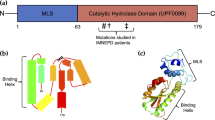Abstract
GPR56 (also known as TM7XN1) is a newly discovered orphan G-protein-coupled receptor (GPCR) of the secretin family that has a role in the development of neural progenitor cells and has been linked to developmental malformations of the human brain. GPR56 diverges from other secretin-like family members in that it has an extremely large N-terminal extracellular region (381 amino acids) and contains a novel feature among this new subclass, consisting of four cysteine residues that define a GPCR proteolytic site (GPS motif) located just before the first transmembrane spanning domain. The rest of the amino-terminal domain contains a large number of possible N- and O-linked glycosylation sites similar to mucin-like proteins. These features suggest a role in cell–cell, or cell–matrix interactions. Here, we demonstrate upregulation of GPR56 in glioblastoma multiforme tumors using functional genomics. Immunohistochemistry studies confirmed the expression of GPR56 protein in a majority of glioblastoma/astrocytoma tumor samples with undetectable levels of expression in normal adult brain tissue. Immunofluorescence analysis of human glioma cells using anti-GPR56 antibodies demonstrate that GPR56 is expressed on the leading edge of membrane filopodia and colocalizes with α-actinin. Purified recombinant GPR56 extracellular domain protein inhibits glioma cell adhesion and causes abnormal cytoskeletal morphology and cell rounding. These results indicate that the extracellular domain may compete for unidentified ligand(s), and block the normal function of GPR56 in cell attachment. In reporter assays, overexpression of GPR56 activates the NF-κB, PAI-1 and TCF transcriptional response elements. These pathways have been implicated in cytoskeletal signaling, adhesion and tumor biology. The above results indicate that GPR56 serves as an adhesion GPCR and is involved in adhesion signaling.
This is a preview of subscription content, access via your institution
Access options
Subscribe to this journal
Receive 50 print issues and online access
$259.00 per year
only $5.18 per issue
Buy this article
- Purchase on Springer Link
- Instant access to full article PDF
Prices may be subject to local taxes which are calculated during checkout






Similar content being viewed by others
References
Belkin AM, Akimov SS, Zaritskaya LS, Ratnikov BI, Deryugina EI and Strongin AY . (2001). J. Biol. Chem., 276, 18415–18422.
Berger F, Gay E, Pelletier L, Tropel P and Wion D . (2004). Lancet Oncol., 8, 511–514.
Berger MS and Wilson CB (eds) (1999). The Gliomas. W.B. Saunders Company: London.
Czekay RP, Aertgeerts K, Curriden SA and Loskutoff DJ . (2003). J. Cell Biol., 160, 781–791.
Fredriksson R, Gloriam DE, Hoglund PJ, Lagerstrom MC and Schioth HB . (2003). Biochem. Biophys. Res. Commun., 301, 725–734.
Fredriksson R, Lagerstrom MC, Hoglund PJ and Schioth HB . (2002). FEBS Lett., 531, 407–414.
Haier J, Goldmann U, Hotz B, Runkel N and Keilholz U . (2002). Clin. Exp. Metast., 19, 665–672.
Hamann J, van Zeventer C, Biji A, Molenaar C, Tesselaar K and van Lier RAW . (2000). Int Immunol, 12, 439–448.
Hayflick JS . (2000). J. Recept. Signal Transduct. Res., 20, 119–131.
Honda K, Yamada T, Endo R, Ino Y, Gotoh M, Tsuda H, Yamada Y, Chiba H and Hirohashi S . (1998). J. Cell Biol., 140, 1383–1393.
Kierszenbaum AL . (2003). Mol. Rep. Dev., 64, 1–3.
Krasnoperov V, Bittner MA, Holz RW, Chepurny O and Petrenko AG . (1999). J. Biol. Chem., 274, 3590–3596.
Krasnoperov V, Lu Y, Buryanovsky L, Neubert TA, Ichtchenko K and Petrenko AG . (2002). J. Biol. Chem., 277, 46518–46526.
Little KD, Hemler ME and Stipp CS . (2004). Mol. Biol. Cell, 15, 2375–2387.
Liu M, Parker RMC, Darby K, Eyre HJ, Copeland NG, Crawford J, Gilbert DJ, Sutherland GR, Jenkins NA and Herzog H . (1999). Genomics, 55, 296–305.
Mueller S, Kunkel P, Lamszus K, Ulbricht U, Lorente GA, Nelson AN, von Schack D, Chen DJ, Lohr SC, Westphal M and Melcher T . (2003). Oncogene, 22, 6661–6668.
Obermann H, Samalecos A, Osterhoff C, Schroder B, Heller R and Kirchhoff C . (2003). Mol. Reprod. Dev., 64, 13–26.
Orford K, Orford C and Byers SW . (1999). J. Cell Biol., 146, 855–867.
Piao X, Hill RS, Bodell A, Chang BS, Basel-Vanagaite L, Straussberg R, Dobyns WB, Qasrawi B, Winter RM, Innes AM, Voit T, Ross ME, Michaud JL, Déscarie J-C, Barkovich AJ and Walsh CA . (2004). Science, 303, 2033–2036.
Singh SK, Clarke ID, Terasaki M, Bonn VE, Hawkins C, Squire J and Dirks PB . (2003). Cancer Res., 63, 5821–5828.
Terskikh AV, Easterday MC, Li L, Hood L, Kornbum HI, Geschwind DH and Weissman IL . (2001). Proc. Natl. Acad. Sci., 98, 7934–7939.
Woods AJ, Roberts MS, Choudhary J, Barry ST, Mazaki Y, Sabe H, Morley SJ, Critchley DR and Norman JC . (2002). J. Biol. Chem., 277, 6428–6437.
Zendman AJW, Cornelissen IM, Weidle UH, Ruiter DJ and van Muijen GNP . (1999). FEBS Lett., 446, 292–298.
Author information
Authors and Affiliations
Corresponding author
Rights and permissions
About this article
Cite this article
Shashidhar, S., Lorente, G., Nagavarapu, U. et al. GPR56 is a GPCR that is overexpressed in gliomas and functions in tumor cell adhesion. Oncogene 24, 1673–1682 (2005). https://doi.org/10.1038/sj.onc.1208395
Received:
Revised:
Accepted:
Published:
Issue Date:
DOI: https://doi.org/10.1038/sj.onc.1208395
Keywords
This article is cited by
-
Abnormal glycosylation in glioma: related changes in biology, biomarkers and targeted therapy
Biomarker Research (2023)
-
Signaling pathways in cancer metabolism: mechanisms and therapeutic targets
Signal Transduction and Targeted Therapy (2023)
-
Isoform- and ligand-specific modulation of the adhesion GPCR ADGRL3/Latrophilin3 by a synthetic binder
Nature Communications (2023)
-
An antibody–drug conjugate targeting GPR56 demonstrates efficacy in preclinical models of colorectal cancer
British Journal of Cancer (2023)
-
GPR56 signaling pathway network and its dynamics in the mesenchymal transition of glioblastoma
Journal of Cell Communication and Signaling (2023)



